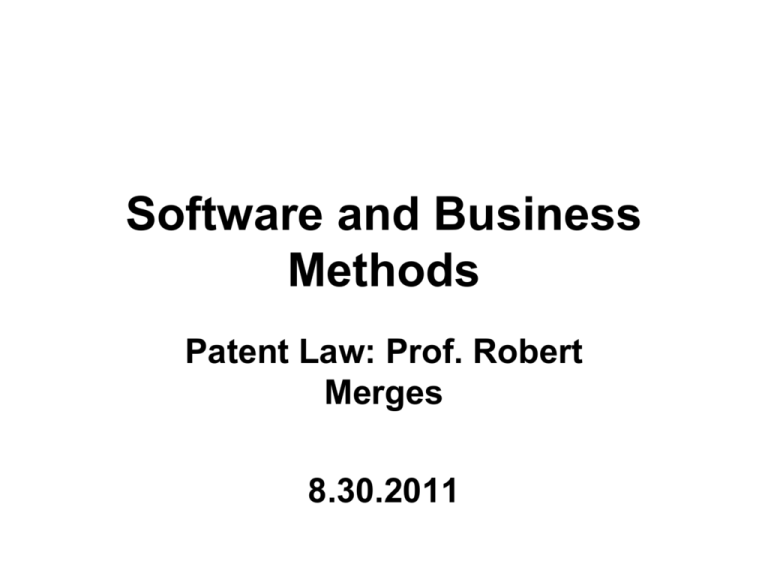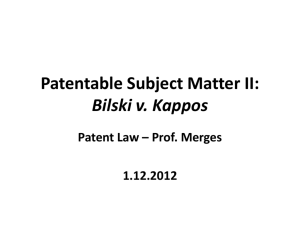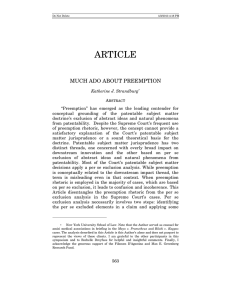Software and Business Methods
advertisement

Software and Business Methods Patent Law: Prof. Robert Merges 8.30.2011 Subject Matter: Overview § 101 Categories • Process • Machine • Manufacture • Composition of Matter • Improvements In re Bilski 130 S Ct 3218 (2010) • Messrs. Bilski and Barnard filed their patent application on April 10, 1997. • Claims were rejected by examiner and appealed to Board of Patent Appeals and Interferences (“BPAI”). • BPAI issued decision sustaining the rejection of all the claims in an order Sept. 26, 2006. • An appeal from the BPAI was made to the Court of Appeals for the Federal Circuit (CAFC). • Prior to disposition by the regular three-judge panel, the CAFC sua sponte ordered en banc review. A method for managing the consumption risk costs of a commodity sold by a commodity provider at a fixed price comprising the steps of: (a) initiating a series of transactions between said commodity provider and consumers of said commodity wherein said consumers purchase said commodity at a fixed rate based upon historical averages, said fixed rate corresponding to a risk position of said consumer; Bilski claim 1 cont’d (b) identifying market participants for said commodity having a counter-risk position to said consumers; and (c) initiating a series of transactions between said commodity provider and said market participants at a second fixed rate such that said series of market participant transactions balances the risk position of said series of consumer transactions. What is this claim about? • Fixed price contract: creates a risk that prices will fall; protects against the risk that prices will rise • What if you wanted to reduce the risk without losing the protection? Hedging • Simple examples: travel insurance; spending money on a “backup plan” • More formally: Hedging risk from a major purchase by making an offsetting investment WeatherWise USA, located in Pittsburgh, PA, is the premier provider of customized consumer energy products including SetYourBillSM, WeatherProof Bill®: fixed bills, capped bills, EnerCheck® energy efficiency . . . Our unique use of computerized models based on engineering, rather than econometric principles enables the development of products and services that reduce financial risk for energy providers and their residential and commercial consumers. Can you patent something like this? • The section 101 question • NOTE: Distinct from other requirements of patentability – NOT asking whether claim 1 in Bilski is new, nonobvious, etc. Bilski v. Kappos • Holding • “Roads not taken” • History, context – and future? The Court's precedents provide three specific exceptions to § 101's broad patent-eligibility principles: “laws of nature, physical phenomena, and abstract ideas.” Chakrabarty, supra, at 309. While these exceptions are not required by the statutory text, they are consistent with the notion that a patentable process must be “new and useful.” And, in any case, these exceptions have defined the reach of the statute as a matter of statutory stare decisis going back 150 years. -- Casebook, p.81 The Holding Rather than adopting categorical rules that might have wide-ranging and unforeseen impacts, the Court resolves this case narrowly on the basis of this Court's decisions in Benson, Flook, and Diehr, which show that petitioners' claims are not patentable processes because they are attempts to patent abstract ideas. Indeed, all members of the Court agree that the patent application at issue here falls outside of § 101 because it claims an abstract idea. Two “Roads Not Taken” 1.Federal Circuit “machine or transformation” test 2.“Categorical prohibition” on business methods Under the Court of Appeals' formulation, an invention is a “process” only if: “(1) it is tied to a particular machine or apparatus, or (2) it transforms a particular article into a different state or thing.” 545 F.3d, at 954. This Court has “more than once cautioned that courts ‘should not read into the patent laws limitations and conditions which the legislature has not expressed.’ ” Diamond v. Diehr . . . . Ordinary meaning: Adopting the machine-ortransformation test as the sole test for what constitutes a “process” (as opposed to just an important and useful clue) violates [several] statutory interpretation principles. Categorical exclusion • Again, plain meaning; dictionary definition of “process” does not exclude business methods/processes • Section 273(b)(1) of the Patent Act – prior user defense for business methods The Holding (again) Rather than adopting categorical rules that might have wide-ranging and unforeseen impacts, the Court resolves this case narrowly on the basis of this Court's decisions in Benson, Flook, and Diehr, which show that petitioners' claims are not patentable processes because they are attempts to patent abstract ideas. Indeed, all members of the Court agree that the patent application at issue here falls outside of § 101 because it claims an abstract idea. Holding (cont’d) The concept of hedging, described in claim 1 and reduced to a mathematical formula in claim 4, is an unpatentable abstract idea, just like the algorithms at issue in Benson and Flook. Allowing petitioners to patent risk hedging would pre-empt use of this approach in all fields, and would effectively grant a monopoly over an abstract idea. One rejected view Respondent urges the Court to look to the other patentable categories in § 101-machines, manufactures, and compositions of matter-to confine the meaning of “process” to a machine or transformation, under the doctrine of noscitur a sociis. Under this canon, “an ambiguous term may be given more precise content by the neighboring words with which it is associated. [But] § 100(b) already explicitly defines the term “process.” What lies behind this rejected view? • “Patents are about technology” – machines, manufactures, compositions of matter . . . • “Technological arts” concept in Europe and some earlier US cases: rejected The plurality portions of the majority opinion – Justice Kennedy The machine-or-transformation test may well provide a sufficient basis for evaluating processes similar to those in the Industrial Age-for example, inventions grounded in a physical or other tangible form. But there are reasons to doubt whether the test should be the sole criterion for determining the patentability of inventions in the Information Age. Dissent: Justice Stevens The wiser course would have been to hold that petitioners' method is not a “process” because it describes only a general method of engaging in business transactions-and business methods are not patentable. More precisely, although a process is not patent-ineligible simply because it is useful for conducting business, a claim that merely describes a method of doing business does not qualify as a “process” under § 101. Dissent (cont’d) “[p]erhaps this was in part a function of an understanding – shared widely among legislators, courts, patent office officials, and inventors – about what patents were meant to protect. Everyone knew that manufactures and machines were at the core of the patent system.” Merges, Property Rights for Business Concepts and Patent System Reform, 14 Berkeley Tech. L.J. 577, 585 (1999) (hereinafter Merges) State Street Bank • Two parts: – Software patents – Business method patents Software Patents Issued 16000 6000 Approx. 600 1982 3000 1500 1986 1990 1994 1998 Application data • USPTO saw 425,967 patent application filings in 2006, a 9.0 percent increase over 2005 levels. Huge Growth in PTO Budget, Examiner Hiring • Now a $2 billion agency • Hired thousands of new examiners in the past few years – Turnover problems … Reactions to the “Patent Flood” • Revisit patentable subject matter • Process reforms • Radically alter the system AS MANY AS SIX IMPOSSIBLE PATENTS BEFORE BREAKFAST: PROPERTY RIGHTS FOR BUSINESS CONCEPTS AND PATENT SYSTEM REFORM, 14 BTLJ 577 (1999) By Robert P. Merges State Street Bank MF MF MF HUB (Pooled fund) MF MF MF MF MF Computer software: method of doing business “Patent Failure”, Bessen and Meurer United States Patent 7,249,083 Noraev , et al. July 24, 2007 Securities, supporting systems and methods thereof: Lehman Brothers Abstract A financial instrument, equity dilution inhibitor and security upgrade account are disclosed based on an enhanced call-spread option. Implementation of the investment vehicle and/or upgrade account are managed via program controlled data processor governing system operation in accordance with investment parameters. Enhanced flexibility for this investment vehicle increases its usefulness to a broad spectrum of potential investors 1. A computer implemented method for creating an investment vehicle, comprising: creating via software stored on a computer a debt security providing a fixed income return to a purchaser for a pre-set period of time that further provides to said purchaser an equity conversion arrangement for a select underlying equity security based on future contingent events; and creating … a derivative instrument coupled to, but separate from, said debt security by providing an option to an issuer of said debt security to purchase shares of said equity security at a select price … • Merges, Software and Patent Scope: A Report from the Middle Innings, 85 Tex. L. Rev. 1528 (2007) Section 101 Reform • “Technological arts” test – Refine categories of patentable subject matter; look to history in a general way . . . • Test each claimed invention more rigorously – Create a test that weeds out the “clearly flaky” from the “clearly inventive” In re Comiskey, 499 F.3d 1365 (Fed. Cir. 2007) • Comiskey’s patent application No. 09/461,742 claims a method and system for mandatory arbitration involving legal documents, such as wills or contracts. [W]e conclude that Comiskey's independent claims 1 and 32 and most of their dependent claims are unpatentable subject matter under 35 U.S.C. § 101. Post-Bilski Trends to Watch • Supreme Court developments: continuing supervision of patent system or “back to the sidelines”? • Software patents The latest twist . . . • CyberSource Corp. v. Retail Decisions, Inc., 99 U.S.P.Q.2d 1690 (Fed. Cir. Aug. 16, 2011) • “Beauregard claims” – “article of manufacture” being software embodied on a diskette or in hard drive Opinion by Judge Dyk • Claim to fraud prevention program on disk is not patentable



![Introduction [max 1 pg]](http://s3.studylib.net/store/data/007168054_1-d63441680c3a2b0b41ae7f89ed2aefb8-300x300.png)

